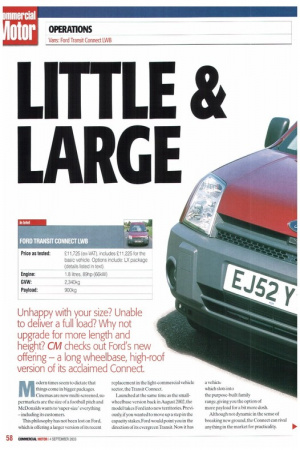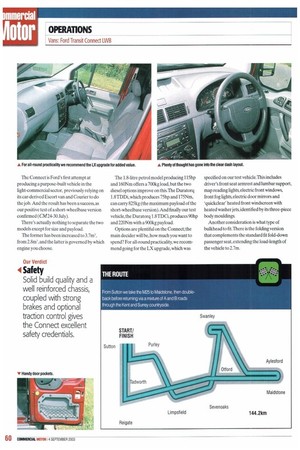I. ME 8t IA G
Page 58

Page 60

Page 61

If you've noticed an error in this article please click here to report it so we can fix it.
Unhappy with your size? Unable to deliver a full load? Why not upgrade for more length and height? CM checKs out Ford's new offering — a long wheelbase, high-roof version of its acclaimed Connect.
Modern times seem to dictate that things come in bigger packages. Cinemas are now multi-screened, supermarkets are the size of a football pitch and McDonalds wants to 'super-size' everything — including its customers.
This philosophy has not been lost on Ford, which is offering a larger version of its recent replacement in the light-commercial vehicle sector, theTransit Connect.
Launched at the same time as the smallwheelbase version back inAugust 2002, the model takes Ford into new territories.Previously,if you wanted to move up a step in the capacity stakes,Ford would point you in the direction of its evergreenTransit. Now it has a vehicle which slots into the purpose-built family range, giving you the option of more payload for a bit more dosh.
Although not dynamic in the sense of breaking new ground, the Connect can rival anything in the market for practicality. The Connect is Ford's first attempt at producing a purpose-built vehicle in the light-commercial sector, previously relying on its car-derived Escort van and Courier to do the job. And the result has been a success, as our positive test of a short-wheelbase version confirmed (CM24-30 July).
There's actually nothing to separate the two models except for size and payload.
The former has been increased to 3.7m3, from 2.8rn, and the latter is governed by which engine you choose. The 1.8-litre petrol model producing 115hp and 16ONm offers a 700kg load, but the two diesel options improve on this. The Duratorq 1.8 TDDi, which produces 75hp and 175Nm, can carry 825kg (the maximum payload of the short-wheelbase version).And finally our test vehicle, the Duratorq 1.STDCi, produces 90hp and 220Nnri with a 900kg payload.
Options are plentiful on the Connect; the main decider will be, how much you want to spend? For all-round practicality, we recommend going for the LX upgrade, which was specified on our test vehiele.This includes driver's front seat armrest and lumbar support, map reading lights, electric front windows, front fog lights, electric door mirrors and 'quickclear heated front windscreen with heated washer jets, identified by its three-piece body mouldings.
Another consideration is what type of bulkhead to fit.There is the folding version that complements the standard fit fold-down passenger seat,extending the load-length of the vehicle to 2.7m. Or should you go for the ladder-frame, the half-height or the full bulkhead?
The same goes for the side load doors. You can specify single, double or no sliding doors. And all load doors can be glazed,unless you need some privacy for your cargo.
This plethora of options gives some idea of the thought that has gone into the Connect. And we think it's a good-looking vehicle. It does lose some of its cool in its long-wheelbase guise, but it has a certain squat, compact look that is in keeping with its character.
PRODUCTIVITY Our previous test of the short-wheelbase Connect delivered average fuel economy compared to its rivals, at 43.2mpg. But once its extra payload and body strengthening were factored in, the result was corrirnendable.With this in mind,it was a pleasant surprise when the long-wheelbase gave a figure of 42.3mpg.
Again, it has to be remembered that this is a bigger van with an increased payload; a pretty good result.When it comes to load performance,Ford has made some strong claims. Firstly there is the actual design.There is very little 'tumble-home' on the side panels to maximise upper space in the load compartment, resulting in 100mtn more roof height than its nearest competitor. It can also accommodate 8x4ft boards, which gives it a further edge over the competition.
A look at the weight stakes sees the Connect deliver a gross payload of 900kg, which compares favourably with the Fiat Scudo at 810kg and the Nissan Vanette Eat 845kg.
Actual volume sits somewhere between the two rivals: the Fiat offers 4.0m3, with the Nissan slightly less at 3.8m3. At 3.7m3 the Connect cannot claim any prizes, but fold down the passenger seat and this becomes 4.4m3.
ON THE ROAD One area in which the Connect excels is in the way it drives. Its sure-footedness and all-round driveability is up there with the best in class.
It's no hot-hatch— the Connect goes about its business in a calm and composed manner — but it turns into corners with real enthusiasm while giving the driver plenty of feedback on what the suspension is doing.
Since the Connect was purpose-built,Ford was able to incorporate extra strengthening in key areas such as the loadbox side panels, and use heavy-duty components in areas such as the suspension and braking system.The end product is a vehicle that feels capable of taking a hammering and coming back for more. Its power is by no means overshadowed eitherThe Duratorq engine is happy to be pushed through the revs and offers a usable amount of torque to help keep your speed up. Engine noise is well suppressed and vibration is kept to a minimum.
The cab is well thought-out with a good driving position, achievable through the many adjustable options on seat and steering wheel.
If you need to carry a lot of paperwork or files, our advice is to specify the optional roofmounted parcel shelf at £50. •
















































































































































































































